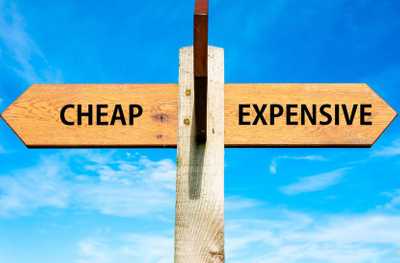Selling a Cheap vs. Expensive Product
June 09, 2020
Hey, how is it going? It’s Jordan the Millionaire Millennial. I wanna talk about the difference in pricing structures, when selling products. Whether you should go for a more expensive or a cheaper product.

When you are first starting out, you will naturally want to go for a cheaper product simply because it is easier to get your hands on and sell. I mean, it is easier to sell a $10 product than a $100 product, right? However, before you start selling, I wanna give you some insight on the benefits of selling that $100 product to the $10 product. As well as, why I personally choose to sell a more expensive product every time.
Jumping right into this, if you have a cheap product, let's say $10 or even $20, something that is relatively inexpensive and easy to produce. You will have to sell a lot of those products, consistently, to make a sustainable income. Meaning, you will need to be selling 100s if not 1000s of these products monthly to make consistent returns.
As compared to a more expensive product, let’s say $200, you will only need to sell a 10th the amount to make the same income. Personally, this is a huge draw to me because it lowers the amount of people I need to sell to and still make the same amount of revenue. However, something that may not seem so obvious, is the cost of acquisition for a more expensive product to that of a cheaper product
Hypothetically speaking, let's say your product cost $20 and you have to spend $20 to acquire a customer. You are barely breaking even when selling this product, if at all. Now let us say you are selling a $200 product, you can spend $100 or even $150 to acquire that customer.You may have spent a good bit of money to get that customer, but you are coming out ahead with a profit.
To add to this, customer acquisition is not easy. Finding your buyers and niche is just one part of the puzzle, but actually getting them to buy your product is the real challenging part! Being able to spend that money to acquire your buyers helps a lot in this step, especially when you know your customers are willing to pay $200 for your product!
This then opens the gates, if you will, to a lot of different marketing strategies that weren’t available to you when you were selling cheaper products. Cheaper products primarily have 1 or 2 different marketing strategies which are basically free or organic. And let me tell you, organic takes a long time to get rolling.
I am sure you don’t want to be waiting around for 6 months to get traction when jumping into the market with a new product. This makes having the ability to have some form of paid marketing invaluable. And this is why having a more expensive product can be very favorable.
This doesn't apply just to physical products,this applies to digital products as well as software products.

For example, my first software company, Atlas, charged $85 a month. That was the cheapest I charged and I went up to $139 as the software became more valuable. Our user base was a decent size, and we did not need to hunt down 1000s of people to make a really good profit.
This is a great example of selling a product or software that was more expensive, and requiring a smaller customer base to make a really good income. Now I've ultimately sold that business, exited it for a good bit of money. I'll write more about that in another blog post, but back to the topic at hand. The pricing structure for Atlas worked really well which is why I'm a fan of the more expensive pricing structures
Customer affiliation and relationship is another big reason I prefer more expensive products. Due to your product being more expensive you will have less customers but, you will be more familiar and helpful to your customers.

Like I stated earlier, you would have to have 10 times more customers for the cheaper products as compared to the expensive products. This makes dealing with one person and helping that one person a lot easier. Which will ultimately help improve your product and get better reviews. Simply put, it's easier to serve one person than it is 10, because you can focus on that one person and can be more intimate with that individual and make sure that they're taken care of.
This is something that is not super intuitive from the beginning and is something I didn't really think of when I first started out. Looking back years ago, one of my very first products I ever sold was on Amazon. I believe I sold it for around $22 and this was way back before I knew anything at all.
I had no concept of customer acquisition costs, lifetime value, repeat customers and all the other important aspects of selling products. I didn't think or know about any of this stuff, I just picked a product that was selling well and went with it, thinking this will work out!
Well, ultimately that product did not sell too well. I had no returning customers and my cost of acquisitions were only increasing, at the end of the day I was barely breaking even. To combat this, I did a little more research into selling products and on marketing strategies before selling my next product. I ended up choosing a more expensive product to sell, which was around $60.
I was having a much easier time selling this product and also having higher margins because I was able to spend more money towards the marketing side. This helped solidify my opinions to why having a more expensive product is easier and better to sell. I was able to spend more money on acquiring customers and still end up getting high returns.
Pricing is a very important aspect when selling anything. Knowing the true value of what you are selling and what you can appropriately sell it for is key, you cannot and should not sell a $20 product for $200. This will only tarnish your product and ultimately you as a seller. So, before you even make a product, think about the value of the product both perceived from a consumer and from you as a producer.
If you are trying to target a more expensive physical product, you should be looking in the electronic department or maybe just a large product in general, like a canoe haha. There are millions of different expensive physical products out there that can be sold, you just need to find them! Now if you're thinking about digital products, you can definitely make courses or other information products.

These can be really valuable but can require a lot of time and effort into making them. There are information products out there that are $10,000 and then there's information products out there that are $10. A good example of this is Udemy, they have plenty of courses there that are 10 bucks ,but there's also plenty of courses on there for $10,000.
The difference between those, in terms of quality, is obviously huge, but also the difference between those in terms of interaction with the teacher is orders of magnitude higher. Let's say you pay $10 for a course on Udemy, you're not going to be able to talk to the teacher, sorry it is just not going to happen. If you're paying $10,000 for a course, you will be able to interact with the teacher a lot more and can get a lot more personal help out of it.
A perfect example is going to college: you're paying five grand a semester. You can go to your professors office hours for almost all of your professors and get help or just talk to them. This is actually really valuable and sadly I know most college students don't utilize this. I know I didn't, at least, until senior year when I started realizing “Hey, I should actually talk to the people that do this in real life - that have been in the industry for 20 years, they may know what they're doing.” Once I realized this, is when I started going to my teacher's office hours.
This is not something that you get when you buy a really cheap product. So, when you create a highly valuable product, something that people will actually want to buy, interaction between you and the consumer will be high and will create a better business. This I think just makes even more sense to have a more expensive product, but of course this is just my opinion.
Now if you are just wanting to make $10 products and you just want to sell tons of them, then by all means go for it. Just know, from personal experience, It will be more difficult. Personally, I find it more difficult to sell a lot of a cheaper product than it is to sell just a few of a more expensive product.
The beauty of that more expensive product as well is the higher quality you are selling to the buyer. You are spending the time, effort, money and focus into making a good, high quality product that will improve with time. As well as learning all the different marketing strategies that will help you sell more products in the future.This is the core of what I wanted to cover in this blog, which is highlighting the difference between the lower cost versus the higher cost products.
I get that when you're first starting out it's hard to even think of buying a more expensive product. Risking and possibly losing a decent amount of money, but really the best way to find a market that's willing to buy your expensive product is to look at already rich people. Sounds kind of obvious and it is but when selling richer people then you know the income of your consumers. You know they have the income to spend and buy your product so it is up to you to sell to them. What better example is there than designer brands like Gucci.

They make and target clothing for rich people by marketing it at a really expensive price. Obviously they produce high quality stuff and there's a level of status that you get while wearing their brand and other such perks. This is an example of what I am trying to say: find people that can afford a product that is more expensive. Then figure out what those people want or need, then make and sell that product.
Going back to my first software company Atlas, it’s a product specifically targeted at amazon sellers. Because they sell on Amazon I knew that they had some level of disposable income that they are willing to spend. I built the product with the price in mind and knew they would be willing to spend that 80 bucks a month to make their job even easier for them.
It made sense and worked out really well for both me and them, because at the end of the day I knew what they needed/ wanted and how much they would be willing to spend on it. I know I am making this sound really easy, but it’s not. This really took me a while to figure out and master it and even then there are always improvements to be made.
However, I just wanted to write this blog for y’all, to give some insight and knowledge into some of the things I have learned over the years, both failures and success. In hopes that you can learn from the mistakes I have made and not replicate them. I am going to be sharing more tips and tricks I have learned over the years in these upcoming blogs so be on the lookout!
Until next time - take care!
Written by Jordan Kilburn A.K.A. the Millionaire Millennial who lives in Dallas and helps people enjoy life, make money, and build cool stuff. You should follow him on Instagram / YouTube









